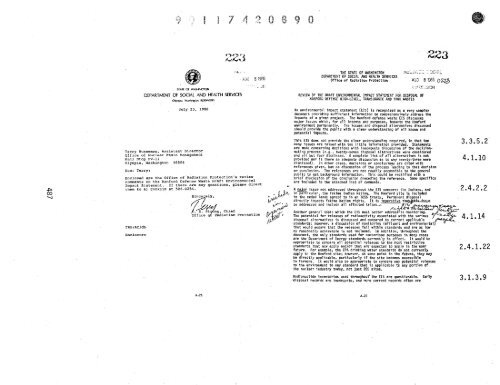EIS-0113_Section_11 - Hanford Site
EIS-0113_Section_11 - Hanford Site
EIS-0113_Section_11 - Hanford Site
You also want an ePaper? Increase the reach of your titles
YUMPU automatically turns print PDFs into web optimized ePapers that Google loves.
'd a 7 g # 0 08 .<br />
am<br />
'.,.: ,- 8hae<br />
SiI.iF b WA4N'rfON<br />
.. J•<br />
DEPARTMEN T OF SOCIAL AND HEALTH SERVICES<br />
CWmde. vv..'saa Wiswmrs<br />
Iuly 23, 1986<br />
Terry Husaeman, Assistant Director<br />
Office of Nuclear Waste Nanagemlat<br />
Mail Stop PV-<strong>11</strong><br />
Olympic, Washington 98584<br />
Dear Terry:<br />
Enclosed are the Office of Radiation Protection's review<br />
ants on the <strong>Hanford</strong>Defense Waste Draft Environmental<br />
Impact Statement. If there are any guosbions, please direct<br />
Q them to Al Conklin at 586-0254.<br />
W,, ,____sly<br />
TRS/AC/dh<br />
enclosure<br />
^, ' R. it on, Chief<br />
Office Protection<br />
THE STATE OF WASHINGTON mt_'+--<br />
DEPARTMENT OF SOCIAL AND HEALTH SERVICES<br />
Office of Radiation Protection AU3 8 1986<br />
^ZZJ<br />
.J<br />
REVIEW OF THE DRAFT ENVIRON ME NTAL IMPACT STATEMENT FOR DISPOSAL OF<br />
HANFORD DEFENSE HIGH-LEVEL, TRANSURANIC AND TANK WASTES<br />
An environmental impact statement (<strong>EIS</strong>) is recognized as a very complex<br />
document providing sufficient information to comprehensively address the<br />
impacts of a given project. The <strong>Hanford</strong> defense waste <strong>EIS</strong> discusses<br />
.jet issues which, for ail intents and p urposes. impacts the <strong>Hanford</strong><br />
environment permanently. The issues, and disposal alternatives discussed<br />
should provide the public with a clear understanding of all known and<br />
potential impacts.<br />
This F.IS does not p ro vide the clear understanding requi re d, in that too<br />
many issues are raised With too little information provided. Statements<br />
are made concerning decisions with inadequate discussion of the decisionmaking<br />
process (e.g., twenty-seven disposal alternatives were considered<br />
and all but four dismissed. A complete list of all alternatives is not<br />
Provided nor is there an adequate discussion as to why twenty-three were<br />
dismissed). In other cases, decisions or conclusions are cited with<br />
references given, but no discussion of the process leading to that decision<br />
or conclusion. The references are not readily accessible to the general<br />
public to get background information. This could be rectified with a<br />
brief discussion of the conclusion preceding the reference. Some specifics<br />
ame included to the attached list of co mm ents.<br />
A major issue not addressed Indian the <strong>EIS</strong> concerns the Indians, and<br />
in the ceuiiq the Yakima Nation. Natioon. The <strong>Hanford</strong> site is include d<br />
in the ceded lands agreed to in an treaty; Pertinent disposal<br />
directly impacts ud Natf on rights.. It 15 imperative th e is-tssue<br />
be addressed and include affected tribes ..,<br />
Another general l Which<br />
the <strong>EIS</strong> must better add res is monitoring. ^,y<br />
The potential for releases of radioactivity associated with the various<br />
disposal alternatives is discussed and compared current applicable<br />
standards; however, a discussion monitoring (of effluent and environmental)<br />
that would ensure that be A releaseses fall within standards and are as low<br />
as reasonably achievable is not included. In addition,<br />
ro purpos th ughout the<br />
document, the only standards used for com p arison purposes<br />
in many cases<br />
are ia rtment of Energy standards releas e in effect. It Would be<br />
appropriate<br />
to compare all potentiall releases to<br />
to the most restrictive<br />
standards that now apply and/or that Water to to apply in en<br />
future. For example, the EPA drinking water star standards<br />
do not currently<br />
apply the <strong>Hanford</strong> site; however, at some site[ to the accuse, they may<br />
be directly appli cable, particularly if f the site orn becomes accessible<br />
to anners. it also be appropriate to f<br />
re ca any potential leases<br />
to the ro to pli<br />
environment nment to any standard that is applicable to any portion of<br />
the nuclear industry today, not just ODE sites.<br />
3.3.5.2<br />
4.1.10<br />
2.4.2.2<br />
4.1.14<br />
2.4.1.22<br />
Radionuclide inventories used throughout" the <strong>EIS</strong> are questionable. Early<br />
disposal records are<br />
3.1.3.9<br />
inadequate, and more current records often are<br />
A-26 A-22

















